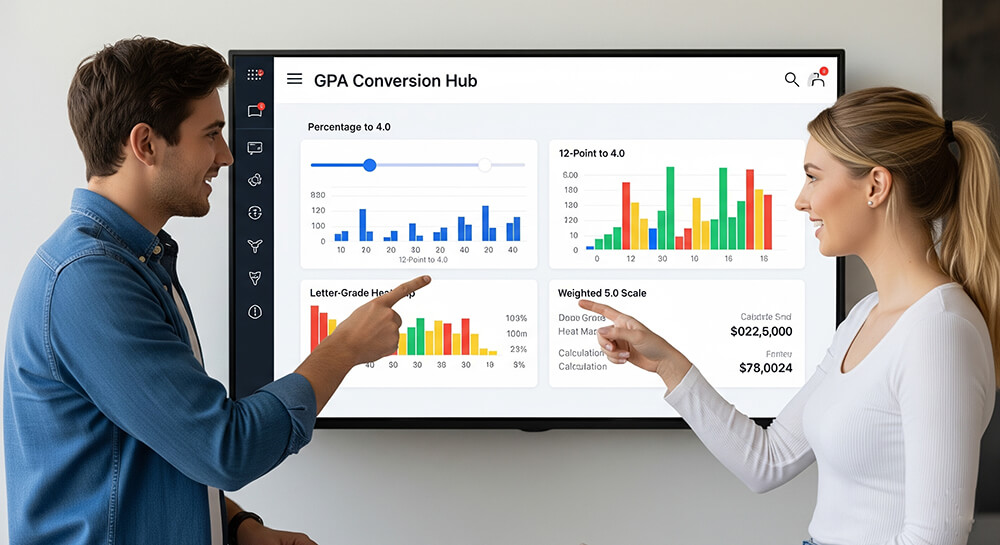Key Takeaways
| Main Point | Description |
|---|---|
| Early Origins | The concept of grading began at Yale in 1785 with descriptive Latin ranks. These were later converted to a 4-point numeric scale, setting the stage for the modern GPA. |
| Standardization | The A-F letter system was first used in 1897. By the 1940s, the 4.0 GPA scale became the standard in the U.S. to create a uniform way to measure student performance. |
| Weighted Systems | To recognize the difficulty of advanced courses like AP and Honors, weighted GPA scales (like the 5.0 scale) were introduced. This allows students to earn a GPA higher than 4.0. |
| Global Variations | Grading systems differ worldwide. Canada often uses a 12-point system, while many European and Latin American countries use 10-point or other numeric scales. |
The Birth of Grading: From Latin Ranks to Numbers
The idea of grading students started at Yale University in 1785. The president, Ezra Stiles, grouped students into four Latin categories: Optimi, Second Optimi, Inferiores, and Pejores. This was the first known system to rank students. By 1837, Yale changed these descriptions into numbers on a 4-point scale. This change from words to numbers was a big step. It created the foundation for the GPA systems we use today and provided an early model for how to calculate GPA.
The Rise of the A-F Letter System
Before the 4.0 scale was common, colleges tried different methods. Harvard used a 100-point system and later a 20-point system. The letter grade system we know today, from A to F, was first used by Mount Holyoke College in 1897. This made it easier to understand a student's performance quickly. Over time, this letter system became very popular. Schools began using a letter to point GPA conversion guide to turn these grades into a numeric average.
Standardization to the 4.0 GPA Scale
During the early 20th century, schools and employers needed a single, clear way to compare students. The A-F system was good, but a numeric average was better for comparison. By the 1940s, the 4.0 GPA scale became the standard across most American colleges and high schools. This system assigned a point value to each letter grade, with 'A' being 4.0. This change made it simple to see a student's overall academic achievement with one number. A clear GPA formula guide helped everyone calculate this new standard.
The Introduction of Weighted GPA for Advanced Courses
As schools created more challenging classes, like Honors and Advanced Placement (AP), a problem appeared. An 'A' in an easy class was worth the same as an 'A' in a very hard class. To fix this, schools introduced weighted GPAs. This system gives extra points for tougher courses. An 'A' in an AP class might be worth 5.0 points instead of 4.0. This rewards students for taking on more difficult work. Understanding the difference between weighted vs. unweighted GPA is key, and a GPA weighting guide for Honors and AP can help explain it.
Understanding the 5.0 GPA Scale
The 5.0 GPA scale is the most common type of weighted GPA. It is designed to show the extra effort students put into advanced classes. On this scale, getting an 'A' in an honors or AP course can raise a student's GPA above 4.0. This helps colleges see which students challenged themselves. A 5.0 GPA scale guide explains how these points are calculated. Students can use a 4.0 vs. 5.0 GPA outcome simulator to see how course selection affects their final GPA.
Alternative GPA Scales Around the World
Not every country uses the 4.0 scale. Grading systems are different all over the world. For example, many universities in Canada use a 12-point scale. Germany uses a 1-6 scale where 1 is the best grade. Other places use a percentage system or a 10-point scale. This variety can make things confusing for international students. It is important to use a 12-point to 4-point scale chart or other conversion tools to compare grades accurately. Some systems even use a 100-point to 5-point conversion.
Modern Tools for GPA Conversion and Calculation
With so many different grading systems, students need help. Today, online tools make it easy to figure out your GPA. A good GPA calculator can save a lot of time and prevent mistakes. These tools can handle different scales and weighting systems. For students applying to schools in other countries, GPA conversion charts and tools are very important. They help translate grades from one system to another, so admission offices can understand a student's record.
How Different Institutions Calculate GPA
Even within the same country, GPA calculation can vary. Different school districts and colleges may have their own rules. Learning how school districts calculate GPA can help high school students understand their transcripts. When applying to college, it is useful to use a college GPA calculator to see how grades might be viewed. Each institution sets its own standards, so what works for one school might be different for another.
Common Issues and Special Cases in GPA
Some situations make GPA calculations tricky. For example, pass/fail classes usually do not affect GPA, but this can vary. Understanding how pass-fail grades impact your GPA is important. Incomplete grades are another special case that requires careful planning. A guide on GPA planning for incomplete grades can help students manage these situations without hurting their academic record.
Frequently Asked Questions (FAQ)
What was the first grading system? The first recorded grading system was at Yale University in 1785, where students were ranked into four Latin categories: Optimi, Second Optimi, Inferiores, and Pejores.
When did the 4.0 GPA scale become standard? The 4.0 GPA scale became the widely adopted standard in the United States by the 1940s as a way to create a uniform metric for colleges and employers.
Why was weighted GPA created? Weighted GPA was created to reward students for taking more challenging courses, such as Honors, AP, or IB classes. It assigns extra points for grades in these difficult courses, allowing a GPA to go above 4.0.
Are there other GPA scales besides 4.0 and 5.0? Yes, many other scales exist globally. Common alternatives include 12-point scales in Canada, 10-point scales in countries like India, and various numeric scales in Europe, such as Germany's 1-6 system.
How can I convert my grades from a different scale? You can convert grades from a different scale by using online conversion tools or charts that map the values from one system to another, such as from a 12-point or percentage scale to the standard 4.0 scale.









